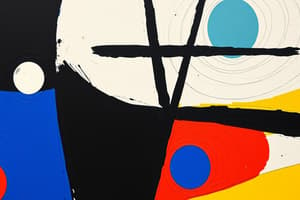Podcast
Questions and Answers
What is the primary technique used in the printing method developed by Jules Cheret?
What is the primary technique used in the printing method developed by Jules Cheret?
- Lithography with a single stone
- Digital printing with color separation
- Screen printing with mesh
- Using multiple stones or plates (correct)
Which characteristic best describes the art movement known as Fauvism?
Which characteristic best describes the art movement known as Fauvism?
- Emphasis on painterly qualities and intense colors (correct)
- Incorporation of complex geometric shapes
- Focus on realistic details and natural colors
- Use of dull, muted colors
What is a key feature of the artistic style focused on dream-like scenes and illogical compositions?
What is a key feature of the artistic style focused on dream-like scenes and illogical compositions?
- Use of symmetrical designs
- Tapping into the unconscious mind (correct)
- Realistic portrayal of everyday life
- Strict adherence to natural forms
Which elements are emphasized in the artistic style that uses straight lines and primary colors?
Which elements are emphasized in the artistic style that uses straight lines and primary colors?
What does the term 'fauves' mean in relation to Fauvism?
What does the term 'fauves' mean in relation to Fauvism?
What is Abstract Expressionism?
What is Abstract Expressionism?
Who developed Chromolithography?
Who developed Chromolithography?
What is the first step in the chromolithography process?
What is the first step in the chromolithography process?
What are the two main attributes of Surrealism?
What are the two main attributes of Surrealism?
What does the term 'Fauvism' come from?
What does the term 'Fauvism' come from?
What are some of the key features of Fauvism?
What are some of the key features of Fauvism?
What does Cubism aim to do?
What does Cubism aim to do?
What are three key features of Neoplasticism?
What are three key features of Neoplasticism?
Flashcards
Lithography
Lithography
A printing method using multiple stones or plates to create colored images.
Fauvism
Fauvism
20th-century art movement using bold colors and simplified forms; named from 'wild beasts'.
Cubism characteristics
Cubism characteristics
Art movement focusing on straight lines, primary colors (red, blue, yellow), and neutral colors with grid-based compositions.
Surrealist art
Surrealist art
Signup and view all the flashcards
Lithography process
Lithography process
Signup and view all the flashcards
Production Planning
Production Planning
Signup and view all the flashcards
Art
Art
Signup and view all the flashcards
Subject in Art
Subject in Art
Signup and view all the flashcards
Representational Art
Representational Art
Signup and view all the flashcards
Non-Representational Art
Non-Representational Art
Signup and view all the flashcards
Medium in Art
Medium in Art
Signup and view all the flashcards
Form in Art
Form in Art
Signup and view all the flashcards
Methods in Art Production
Methods in Art Production
Signup and view all the flashcards
SMART Objectives
SMART Objectives
Signup and view all the flashcards
Title in Art Production
Title in Art Production
Signup and view all the flashcards
Target Audience in Art Production
Target Audience in Art Production
Signup and view all the flashcards
Procedures in Art Production
Procedures in Art Production
Signup and view all the flashcards
Venue in Art Production
Venue in Art Production
Signup and view all the flashcards
Implementation Date in Art Production
Implementation Date in Art Production
Signup and view all the flashcards
Materials in Art Production
Materials in Art Production
Signup and view all the flashcards
Machine in Art Production
Machine in Art Production
Signup and view all the flashcards
Manpower in Art Production
Manpower in Art Production
Signup and view all the flashcards
Objective Arts
Objective Arts
Signup and view all the flashcards
Non-Objective Arts
Non-Objective Arts
Signup and view all the flashcards
Architecture (Objective or Non-Objective?)
Architecture (Objective or Non-Objective?)
Signup and view all the flashcards
Painting (Objective or Non-Objective?)
Painting (Objective or Non-Objective?)
Signup and view all the flashcards
Poem (Objective or Non-Objective?)
Poem (Objective or Non-Objective?)
Signup and view all the flashcards
Music (Objective or Non-Objective?)
Music (Objective or Non-Objective?)
Signup and view all the flashcards
Sculpture (Objective or Non-Objective?)
Sculpture (Objective or Non-Objective?)
Signup and view all the flashcards
Weaving (Objective or Non-Objective?)
Weaving (Objective or Non-Objective?)
Signup and view all the flashcards
Novels (Objective or Non-Objective?)
Novels (Objective or Non-Objective?)
Signup and view all the flashcards
Graphic Arts (Objective or Non-Objective?)
Graphic Arts (Objective or Non-Objective?)
Signup and view all the flashcards
Plastic Arts (Objective or Non-Objective?)
Plastic Arts (Objective or Non-Objective?)
Signup and view all the flashcards
Theater Arts (Objective or Non-Objective?)
Theater Arts (Objective or Non-Objective?)
Signup and view all the flashcards
Study Notes
Newer Techniques in Art
-
Abstract Expressionism: A 20th-century art style emphasizing self-expression and emotions through vibrant colors and symbolic content.
-
Chromolithography: A printing method using multiple stones or plates to create colored images. It involves the artist creating separate plates for each color, inking them, and then pressing them onto paper in layers to achieve the final result. This process ensured precise color alignment. Jules Cheret developed this method.
-
Surrealism: Art characterized by dream-like scenes, illogical compositions, and tapping into the unconscious mind to inspire creativity. Artists in this style frequently explored jarring combinations of objects to produce surprising images.
-
Fauvism: An early 20th-century art movement with bold, vibrant colors and simplified forms; "Fauvism" derives from the French word "fauves," meaning "wild beasts." This movement prioritized color over realistic representation.
-
Cubism: An art style aiming to show all viewpoints of a subject simultaneously, presenting objects in fragmented, geometric shapes like cubes.
-
Neoplasticism: An art style utilizing straight lines, primary colors, and neutral colors in grid-based compositions. Representational forms and curves are excluded.
Studying That Suits You
Use AI to generate personalized quizzes and flashcards to suit your learning preferences.




